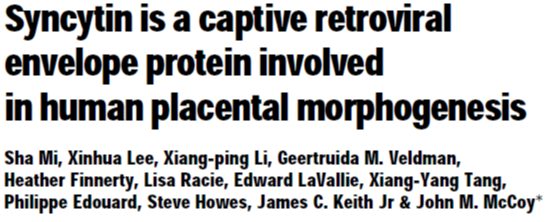A viral grave
I really want to talk about this Jaw Drop since I think people don’t really talk about it enough. I feel like it took me some time to digest this idea and all of its consequences, so let me give it a try.
In my What’s in your genome? Post we discussed the idea that every organism’ DNA is populated by a bunch of different “stuff” besides the normal genes we need to survive. A big part of these are derived from viruses, almost like a viral grave, where viruses deposit and merge with the soil itself.
Some time ago I found this paper and my jaw dropped!

The hidden virus-host interactions
Let me try to explain why this is a pretty big deal. We’ve seen that integrated viral DNA is part of the life cycle of retrovirus and basically it is a process that guarantees the virus to permanently infect the host. It’s a cool strategy that will give benefits only to the virus itself but not really to the infected organism. So far, so good. Nothing new here, virus can influence our genome by inserting their own genes. This, in principle, has no other goal but the one of helping the virus into its infection. At this point is shouldn’t surprise that the opposite can also happens: viruses can acquire genes from their host, by mistake at first, but then it could be useful for them.
Now I quote from the abstract of the paper:
“Many mammalian viruses have acquired genes from their hosts during their evolution. The rationale for these acquisitions is usually quite clear: the captured genes are subverted to provide a selective advantage to the virus. Here we describe the opposite situation, where a viral gene has been sequestered to serve an important function in the physiology of a mammalian host.” (my emphasis)
The mind boggling discovery
What the authors are here suggesting is that a viral gene, coding for syncytin didn’t integrate from a virus into the host just as consequence of the normal life cycle, but this gene has been “promoted” to a higher function into the infected organism! This mean that an external gene that the animal didn’t have before, allowed the infected host to develop a new function! This is already a pretty mind-blowing discovery but let me keep going. In the paper you read also:
“This gene, encoding a protein that we have called syncytin, is the envelope gene of a recently identified human endogenous defective retrovirus […] Our data indicate that syncytin may mediate placental cytotrophoblast fusion in vivo, and thus may be important in human placental morphogenesis.”
If you still don’t understand what it’s going on here let me clear it for you. I already said that they found that this syncytin protein give the host a new function, what is this new function? Well, is placental cytotrophoblast fusion. This, without being too technical, is the fusion between the placenta of the mother and the newborn tissues necessary for the normal birth and growth of a new baby. This could mean that without that viral gene we couldn’t have a new child as we conceive today, or maybe we couldn’t have it at all. This means that the retro viral infection mediated a HUGE step in our evolution because before that infection there were no animals capable of passing nutrient to the child through the placenta. I cite from Wikipedia:
“The largest group of mammals, the placentals, have a placenta, which enables the feeding of the fetus during gestation.”
And guess what? We Humans are part of this group of mammals!
Do you realize that without this viral gene we would have never evolved??? If this is true, syncytin had a colossal importance in our lives. So at least for that, be glad that virus exist for once and let me tell you another story…

Leave a comment